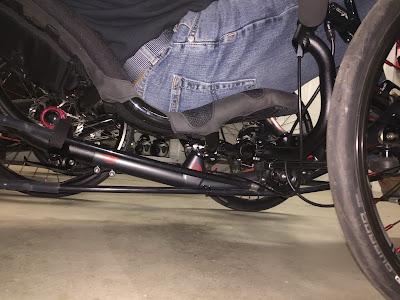I like the ICE Sprint 26fs and it's suspension system. But I can't get totally comfortable with the seat.
After putting a lot of thought and time into figuring out which trike would fit my needs on California's Central Coast (700 v Sprint26fs v Expedition), the seat on the trike I thought would work best the ICE Sprint 26fs is turning out to be my nemesis. After a bad experience with the carbon fiber seat I was convincing myself that the Sprint mesh seat was comfortable for me.
After putting a lot of thought and time into figuring out which trike would fit my needs on California's Central Coast (700 v Sprint26fs v Expedition), the seat on the trike I thought would work best the ICE Sprint 26fs is turning out to be my nemesis. After a bad experience with the carbon fiber seat I was convincing myself that the Sprint mesh seat was comfortable for me.
My hip replacements left me with temperamental pirifomis muscles. They tend to get sore easily and I need a seat that doesn't put pressure on that muscle group. My Catrike 700 and my old Catrike Expedition are very comfortable seats. The mesh seat on the Sprint has it's good days and it's bad days. The design of the Sprint seat puts pressure right where I don't want it. I feel a slight discomfort but a slight discomfort adds up after a couple hours of riding. I so much wanted the Sprint to work for me I overlooked the occasional uncomfortable rides. Those noticeably uncomfortable rides were when I road a little harder. I never had that issue on my 700 or my old Expedition.
I'll probably have to sell the Sprint and maybe I'll add the unsuspended Catrike Expedition to my stable for those days when I feel like a relaxed cruise around the Central Coast. I can use larger volume tires on an Expedition as a compromise to a suspended trike. Going back to having an Expedition keeping my 700 company in the garage is not at all a bad option.
Before making a final decision I contacted ICE to inquire about using the ICE Adventure mesh seat with it's longer seat base. Maybe that might work. Maybe?
On 9/26/17 ICE responded and said they could fit the ICE Adventure seat with it's longer seat base on the Sprint but the end of the seat might hit the back of my thighs when pedaling. I don't feel it would be a problem but I don't want to put anymore money into the Sprint to find out.
On 5/13/19 I picked up my new ICE Sprint FS E8000 and with the Adventure seat and it's work great.
 |
| Catrike 700 mesh seat The seat is longer with no curve at the end. |
 |













